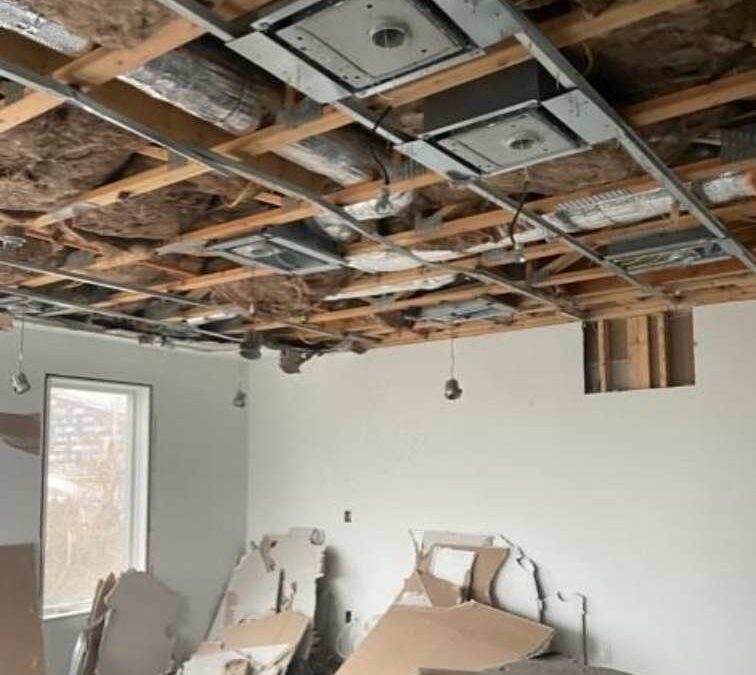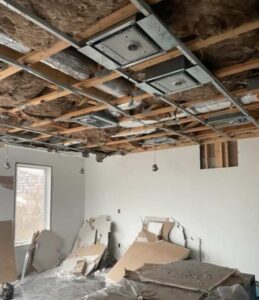How to Do Water Damage Restoration? Water damage is a homeowner’s worst nightmare. Whether due to natural disasters or household mishaps, water damage can have long-lasting and severe consequences. In this guide, we’ll walk you through the entire water damage restoration process and arm you with the knowledge you need to handle these emergencies effectively.
Learn how to effectively perform water damage restoration with our comprehensive guide, covering everything from inspection to reconstruction.
What is Water Damage Restoration?
Water damage restoration is the process of restoring your home to its pre-damaged condition after experiencing water damage. This involves water extraction, drying, cleaning, and ultimately, repair work. While minor water damage can be tackled by homeowners, significant water damage requires the expertise of certified specialists.
Why Timely Water Damage Restoration is Crucial
Delaying water damage restoration poses numerous risks. Structural elements like walls and flooring can weaken, posing a danger to inhabitants. Plus, mold and bacteria growth can lead to severe health problems. On the financial side, delaying restoration could result in higher repair costs in the long run.
Common Causes of Water Damage
Water damage can be caused by several factors:
- Natural disasters like hurricanes and floods
- Malfunctioning household appliances like washing machines
- Plumbing issues, including burst pipes
- Problems with Heating, Ventilation, and Air Conditioning (HVAC) systems
- Initial Steps for Water Damage Assessment
Before jumping into restoration, a few initial steps are crucial:
Safety First: Make sure to turn off electricity and gas supplies to the affected area.
Identify the Source: Stop the water flow, if possible.
Categorize the Water: Water is classified into three categories based on contamination levels, and each requires a different approach.
The Five-Step Process for Water Damage Restoration
Water Damage Inspection
Determine the source and type of water, as each category will dictate the restoration approach.
Assess the class of water damage to determine the extent of saturation.
Water Removal and Extraction
High-powered pumps and vacuums are used to remove standing water. These machines are capable of extracting gallons of water quickly.
Drying and Dehumidification
Once water is extracted, specialized equipment like air movers and dehumidifiers are used to help dry the affected areas.
Cleaning and Sanitization
Personal Protective Equipment (PPE) is essential. Depending on contamination levels, different sanitization techniques are employed.
Repair and Reconstruction
Finally, damaged structural elements may need to be repaired or replaced. Some items can be salvaged, while others may need to be discarded.
Latest Tools and Technologies for 2024
New technology is making the water damage restoration process more efficient:
- SafetyCulture apps facilitate thorough inspection protocols.
- Advanced moisture metres allow for accurate readings.
- The latest dehumidifiers and air movers offer faster drying times.
Comprehensive Steps for Water Damage Restoration
Inspect for Hidden Moisture: After removing visible water, use moisture meters to locate damp spots that might go unnoticed.
Water Removal and Extraction: Use high-powered pumps and vacuums to remove standing water.
Drying and Dehumidification: Utilize advanced drying techniques and dehumidifiers to speed up the drying process.
Mold Inspection and Removal: Once dry, inspect for mold, particularly in hidden corners. Some types of mold can be toxic and may require professional removal.
Removing Damaged Materials: Discard damaged drywall, carpet, and other porous materials. Some areas might be saved through rapid drying.
Cleaning and Disinfecting: Use a bleach solution or other disinfectants to ensure all bacteria and mold are eliminated.
Roof and Siding Check: Inspect for weak spots in the roof or siding and undertake necessary repairs to prevent future damage.
Sealing and Caulking: For long-term prevention, seal new windows, doorways, and other potential leak points.
Final Consult with Insurance: Keep open communication with your insurance provider throughout the process to ensure you’re adequately covered.
Steps to Take for Immediate Action
Water damage can be a complex and urgent issue requiring both immediate and professional attention. Failing to address it promptly could result in further damage and increased risks of mold growth. This article aims to guide you through the steps you should take if your home is afflicted by water damage.
- Locate and Turn Off the Main Water Supply
The first crucial step is to stop the water flow to prevent additional damage. Locate and turn off the main water supply to your home immediately.
- Initial Inspection and Damage Assessment
Before diving into the cleanup, assess the extent and type of water damage. This will help you decide whether you can handle the cleanup yourself or need professional assistance.
- Remove Standing Water
Utilize tools like wet/dry vacuums or mops to remove any standing water from the affected areas. Advanced water extraction equipment may also be used for extensive flooding.
- Use a Dehumidifier
Employ a dehumidifier to remove any lingering moisture from the air. High-tech dehumidifiers can extract moisture even from walls and floors, which is essential for preventing long-term damage.
- Check for Unnoticed Moisture
Perform a comprehensive inspection to find any hidden pockets of moisture. These could result in structural damage if not addressed promptly.
- Structural and Material Assessment
Inspect the affected area for any structural damage. Be particularly vigilant for water damage in porous materials like wood, carpet, and drywall. You may need to remove and replace these materials.
- Sanitization and Disinfection
It’s crucial to clean and disinfect all affected surfaces to minimize health risks and prevent the onset of mold. Specialized cleaning agents may be required for different surfaces and materials.
- Professional Assessment and Restoration
If the damage is extensive or if you suspect hidden problems like mold or structural damage, it is advisable to call a professional water damage repair and restoration company. They can properly assess and treat the damage, often offering emergency services for immediate action.
The Importance of Immediate Damage Assessment
Immediate Assessment: Add a note stressing the importance of an immediate and comprehensive assessment of the water damage. Mention that the type of water (clean, grey, or black) will dictate the restoration approach.
Water Extraction Equipment: Emphasize the use of specialized water extraction equipment and wet/dry vacuums to remove standing water, especially for larger affected areas.
Hidden Moisture: Talk about the importance of looking for hidden moisture that could lead to long-term damage, suggesting specialized moisture meters for accuracy.
High-Grade Dehumidifiers: Recommend the use of high-grade dehumidifiers and industrial fans to expedite the drying process and tackle moisture in walls and flooring.
Sanitization: After drying, emphasize the need for thorough sanitizing and disinfecting of all affected areas to eliminate any lingering bacteria or viruses.
Insurance Communication: Suggest that in cases of severe water damage, contacting the insurance provider can provide further direction and possibly financial support for the restoration process.
Professional Help: Advise readers that for extensive or complicated damage, specialized services like EZ Restoration USA are available 24/7 for emergency assistance. Mention that they offer a structured restoration process that includes inspection, water removal, drying, sanitization, and even complete structural repair if needed.
Conclusion
Restoring your home after water damage is a critical task that should not be taken lightly. With advanced tools and techniques available in 2023, there’s no reason to delay restoration efforts. Being well-informed will help you manage this daunting situation more effectively.
FAQ Section, How to Do Water Damage Restoration?
What is the first step in water damage restoration?
Stopping additional water from entering your property is the first step. It could mean turning off the main water supply or fixing a leak.
How long does it usually take to complete water damage restoration?
The duration varies depending on the extent of the damage but generally ranges from a few days to several weeks.
Is DIY water damage restoration advisable?
For minor issues, DIY may be sufficient. However, professional help is strongly recommended for significant water damage.
What are the potential health risks of untreated water damage?
Untreated water damage can lead to mold and bacterial growth, which can cause respiratory issues and other health problems.
How do you know if your property needs reconstruction after water damage?
Signs of structural weakness, persistent mold issues, and extensive contamination are indicators that reconstruction may be necessary.


